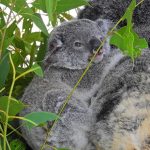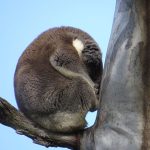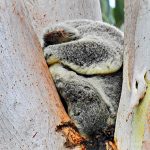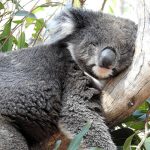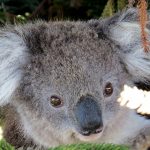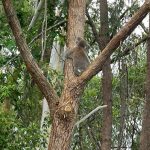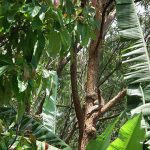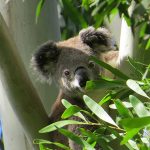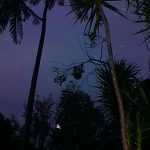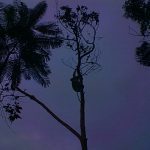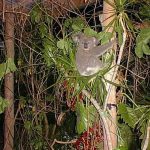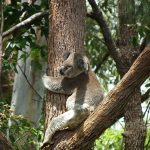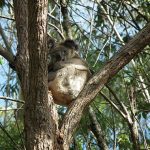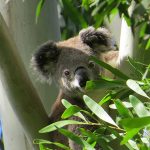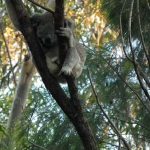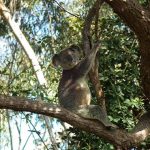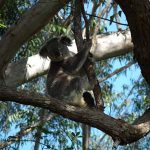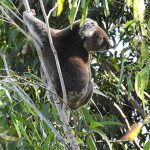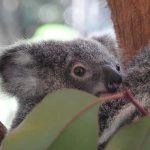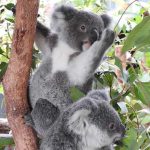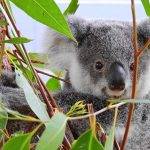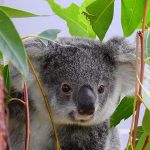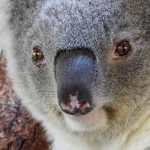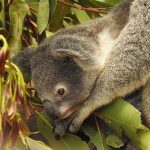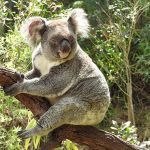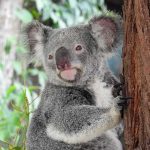KOALA
Sharon:KOALAS feeding on their favourite Gums is always a sight to behold. They are endangered, so it becomes very important to plant more trees for them and to stop removing their habitat trees. Over my 20 plus yrs living in Rosebank in the Northern Rivers of New South Wales, we managed to plant 100’s of native koala gums on our property that was just open paddocks when we first moved in. To my amazement Koalas moved in as soon as the trees could carry their weight. It was a fabulous outcome. So, we encouraged our neighbouring property owners to do the same and eventually 1000’s of gums provided a wonderful Koala Corridor for them to live in.
The Quiet Grace of Koalas: A Story of Survival and Hope
Across the sprawling landscapes of Queensland, New South Wales, Victoria, and South Australia, a gentle presence inhabits the treetops—the koala. These iconic marsupials live high in the arms of ancient Eucalyptus forests, weaving a silent tapestry of survival and serenity that shapes the character of Australian wilderness.
Life in the Treetops: The Koala’s Daily Existence
Perched amongst silver leaves and rugged branches, a koala’s world is softly illuminated by dappled sunlight and cooled by the continuous sigh of the wind.
- Physical Marvels:
Koalas are superbly equipped for their arboreal lifestyle. Their muscular limbs, sharp claws, and opposable thumbs allow them to scale even the smoothest bark with gentle efficiency. - Dietary Specialisation:
The sharp scent of Eucalyptus fills the air—a fragrance koalas know intimately. Nearly all their food comes from a select handful of Eucalyptus species. This tough, fibrous diet is challenging and low in energy, but koalas have evolved a remarkable digestive system that extracts scarce nutrients while neutralising the toxins that deter most other creatures.
A World of Stillness
The slow, rhythmic breathing of a dozing koala blends with the chorus of cicadas and rustle of leaves. Koalas sleep for up to 20 hours a day, their bodies curled tightly in the forks of cool, rough-barked trees. This quietude is vital—it is a life balanced precisely against their sparse diet.
The Rhythm of Spring: A Koala’s Journey
With the arrival of spring, a subtle drama unfolds:
- Tender Beginnings:
Imagine a young koala, its fur soft and grey, hesitantly inching away from the comfort of its mother’s embrace. The cool dawn air carries the musky, earthy aroma of the forest, mingled with anticipation. - The Call of Males:
Far off, the deep, reverberating bellows of male koalas pulse through the forest, a low sound echoing across valleys and ridges. Each call is both a proclamation and an invitation, marking territory and seeking connection. - Risk and Discovery:
As young koalas explore and males embark on long journeys, their paths often intersect with the boundaries of human habitats, bringing them perilously close to roads and suburban gardens.
Hazards and Hope: Coexistence in a Changing World
The encroachment of human activity on koala habitat has introduced a host of challenges:
- Vehicle Strikes:
Roads cut through once-continuous forests, and the quiet movement of koalas is no match for the speed of modern vehicles—especially at dusk and dawn when they are most active. - Dog Attacks:
The scents and sounds of suburbia can mask the presence of koalas from curious dogs, leading to tragic encounters.
Yet, every person has the power to tip the balance toward safety and coexistence.
How You Can Help
Drive Carefully:
- Be alert in koala zones, especially at dawn and dusk.
- Pay close attention to koala crossing signs that warn of frequent movement in these areas.
Responsible Pet Ownership:
- Keep dogs securely indoors or contained at night.
- Leave gentle escape routes—such as a log against a fence—for any koalas that might inadvertently wander into gardens.
Respond to Distress:
- If you spot an injured or confused koala, contact a local wildlife rescue group. Swift action can have a lasting impact.
Guardians of the Forest: The Fight for Habitat
| Threats | Impact | Solutions |
|---|---|---|
| Deforestation | Loss of food and shelter | Tree-planting and corridors |
| Wildfires | Destruction of large forest tracts | Fire management, recovery |
| Urban Expansion | Fragmentation of habitat | Wildlife-friendly gardens |
| Climate Change | Disease, food scarcity, heat stress | Conservation planning |
The Eucalyptus forests, fragrant and shimmering in the sunlight, are the lifeblood of koalas. These woodlands are at risk from clearing, intense fires, and the steady march of development.
Planting Seeds of Hope
A single sapling can become a lifeline.
- Wildlife Corridors:
By creating strips of connected habitat, we give koalas safe routes to travel, find food, and meet others, reducing their vulnerability. - Backyard Biodiversity:
Planting native trees and maintaining green spaces invite wildlife to share our world, blurring the boundaries between ‘theirs’ and ‘ours’.
Conclusion: A Shared Journey
As the shadows lengthen beneath the Southern sky, each of us becomes a custodian of this ancient story. Through vigilance, compassion, and simple actions, we can ensure the koala’s tale continues—not as a struggle, but as a testament to shared hope and respect.
Let us walk together, quietly but resolutely, towards a future where every creature has safe passage beneath the sheltering arms of the Eucalyptus.
Every effort made today is a promise to generations yet to come—a promise that the gentle breath of the koala will always stir the leaves of the Australian forest.


